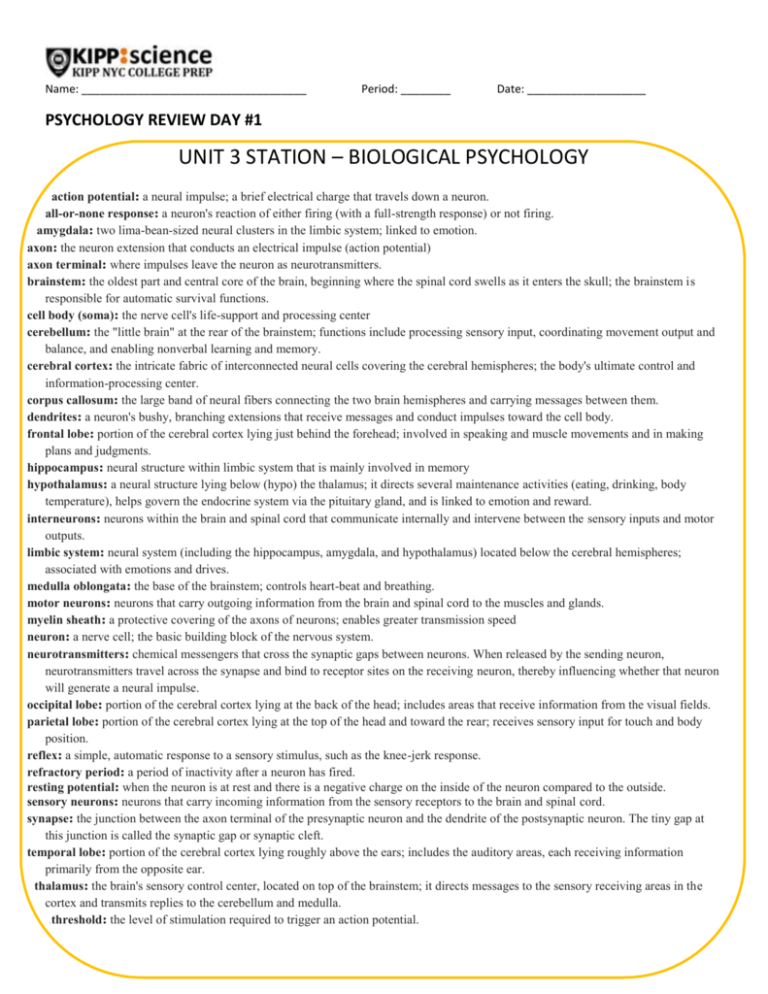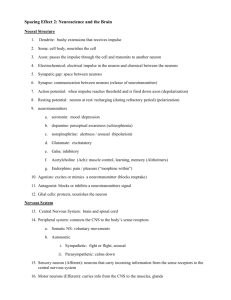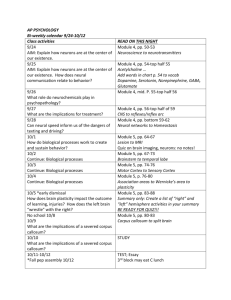Unit 3 Station
advertisement

Name: ____________________________________ Period: ________ Date: ___________________ PSYCHOLOGY REVIEW DAY #1 UNIT 3 STATION – BIOLOGICAL PSYCHOLOGY action potential: a neural impulse; a brief electrical charge that travels down a neuron. all-or-none response: a neuron's reaction of either firing (with a full-strength response) or not firing. amygdala: two lima-bean-sized neural clusters in the limbic system; linked to emotion. axon: the neuron extension that conducts an electrical impulse (action potential) axon terminal: where impulses leave the neuron as neurotransmitters. brainstem: the oldest part and central core of the brain, beginning where the spinal cord swells as it enters the skull; the brainstem is responsible for automatic survival functions. cell body (soma): the nerve cell's life-support and processing center cerebellum: the "little brain" at the rear of the brainstem; functions include processing sensory input, coordinating movement output and balance, and enabling nonverbal learning and memory. cerebral cortex: the intricate fabric of interconnected neural cells covering the cerebral hemispheres; the body's ultimate control and information-processing center. corpus callosum: the large band of neural fibers connecting the two brain hemispheres and carrying messages between them. dendrites: a neuron's bushy, branching extensions that receive messages and conduct impulses toward the cell body. frontal lobe: portion of the cerebral cortex lying just behind the forehead; involved in speaking and muscle movements and in making plans and judgments. hippocampus: neural structure within limbic system that is mainly involved in memory hypothalamus: a neural structure lying below (hypo) the thalamus; it directs several maintenance activities (eating, drinking, body temperature), helps govern the endocrine system via the pituitary gland, and is linked to emotion and reward. interneurons: neurons within the brain and spinal cord that communicate internally and intervene between the sensory inputs and motor outputs. limbic system: neural system (including the hippocampus, amygdala, and hypothalamus) located below the cerebral hemispheres; associated with emotions and drives. medulla oblongata: the base of the brainstem; controls heart-beat and breathing. motor neurons: neurons that carry outgoing information from the brain and spinal cord to the muscles and glands. myelin sheath: a protective covering of the axons of neurons; enables greater transmission speed neuron: a nerve cell; the basic building block of the nervous system. neurotransmitters: chemical messengers that cross the synaptic gaps between neurons. When released by the sending neuron, neurotransmitters travel across the synapse and bind to receptor sites on the receiving neuron, thereby influencing whether that neuron will generate a neural impulse. occipital lobe: portion of the cerebral cortex lying at the back of the head; includes areas that receive information from the visual fields. parietal lobe: portion of the cerebral cortex lying at the top of the head and toward the rear; receives sensory input for touch and body position. reflex: a simple, automatic response to a sensory stimulus, such as the knee-jerk response. refractory period: a period of inactivity after a neuron has fired. resting potential: when the neuron is at rest and there is a negative charge on the inside of the neuron compared to the outside. sensory neurons: neurons that carry incoming information from the sensory receptors to the brain and spinal cord. synapse: the junction between the axon terminal of the presynaptic neuron and the dendrite of the postsynaptic neuron. The tiny gap at this junction is called the synaptic gap or synaptic cleft. temporal lobe: portion of the cerebral cortex lying roughly above the ears; includes the auditory areas, each receiving information primarily from the opposite ear. thalamus: the brain's sensory control center, located on top of the brainstem; it directs messages to the sensory receiving areas in the cortex and transmits replies to the cerebellum and medulla. .threshold: the level of stimulation required to trigger an action potential. Work hard. Be nice. (1) Blindness could result from damage to which cortex and lobe of the brain? a. visual cortex in the frontal lobe b. visual cortex in the temporal lobe c. sensory cortex in the parietal lobe d. cerebral cortex in the occipital lobe (2) Paralysis of the left arm might be explained by a problem in the a. b. c. d. motor cortex in the frontal lobe in the left hemisphere. motor cortex in the frontal lobe in the right hemisphere. sensorimotor cortex in the temporal lobe in the left hemisphere. motor cortex in the parietal lobe in the left hemisphere. (3) Which sentence most closely describes neural transmission? a. An electric charge is created in the neuron, the charge travels down the cell, and chemicals are released that cross the synapse to the next cell. b. A chemical change occurs within the cell, the change causes an electric charge to be produced, and the charge jumps the gap between the nerve cells. c. The electric charge produced chemically inside a group of neurons causes chemical changes in surrounding cells. d. Neurotransmitters produced in the hindbrain are transmitted to the forebrain, causing electric changes in the cerebral cortex. (4) The function of dendrites is to a. receive incoming signals from other neurons. b. release neurotransmitters into the spatial junctions between neurons. c. transmit signals to other neurons. d. control pain through the release of opiate-like chemicals into the brain. (5) The tiny gaps where impulses are chemically transmitted from one neuron to another are called a. neurotransmitters. b. thresholds. c. synapses. d. axons. (6) The conduction of a nerve impulse traveling down an axon is called a(n) a. resting potential c. synapse. b. action potential d. neurotransmitter. (7) The "all-or-nothing response" refers to the fact that a. nerve cells are continuously active. b. action potentials occur completely or not at all. c. an electrical current crosses the synapse completely or not at all. d. all the neurons in a particular "lobe" of the brain fire or none of them fire. (8) When the voltage in the cell is more negative on the inside compared to the outside, the state of the cell is at a. resting potential. b. equilibrium potential. c. state of potential nerve energy. d. action potential. 2 Work hard. Be nice. 3








